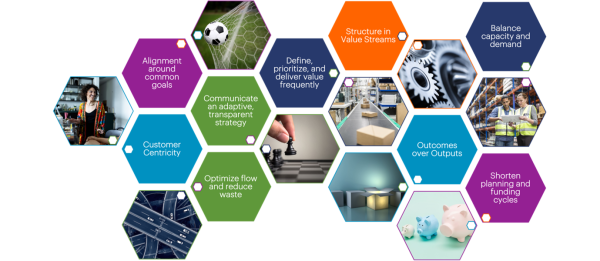Lean Portfolio Management: The Key to Enterprise Agility

Lean Portfolio Management (LPM) is an approach that integrates lean and agile principles to manage portfolios comprising projects, initiatives, and investments. As organizations seek agility at a larger scale, LPM presents an avenue to refine strategic planning, funding, and resource allocation.
For agile teams that have mastered working effectively, the next challenge is scaling that effectiveness. Often, individual teams grapple with external bottlenecks, such as governance hurdles, funding issues, or resource constraints. When attempting to amplify agility across multiple teams, these challenges become widespread. LPM addresses this by seamlessly connecting strategy with execution, all while keeping customers at the forefront.
Every organization is unique, and agility doesn't come with a one-size-fits-all manual. To assist the journey, the Business Agility Institute and ICAgile have co-developed guiding principles for Lean Portfolio Management. Let's dive into them:
- Shift to customer-centricity within a larger context: Focus on delivering value to the customer. Understand their needs and pain points and align the organization's strategy and products to address them. For example, instead of launching products based on internal assumptions, engage with customers, gather feedback, and iterate based on their input.
- Communicate an adaptive strategy with transparency: Share the organisation's vision and strategy openly, allowing teams to align their work accordingly. For example, organisational leaders should use multiple channels to regularly and openly discuss strategic shifts and the reasons behind them.
- Align around common goals, and how they might change: Ensure that all teams and departments work towards shared objectives in short iterative cycles so that you can easily pivot as product needs and market conditions evolve. For example, use Objectives and Key Results (OKRs) to set shared goals and review them quarterly.
- Define, prioritise, and deliver business value frequently: Continuously assess what brings the most value to the business and customers, and prioritise accordingly. For example, implement a simple value prioritisation framework to rank features or initiatives.
- Structure in value streams: Organize teams around value delivery rather than traditional functions or silos. For example, instead of having IT delivery teams and business product teams, create cross-functional teams responsible for a product or service end-to-end that will look after all aspects of delivery and support and be able to react and innovate quickly.
- Take accountability for outcomes over outputs: Focus on the impact of work (outcomes) rather than the volume of work done (outputs). For example, rather than measuring success by the number of features released, measure success by the positive impact on customer satisfaction or revenue.
- Optimise flow and reduce waste across the whole system: Streamline processes, eliminate bottlenecks, and reduce any activities that don't add value. For example, implement value stream mapping and visual and transparent tooling to visualize and improve the flow of work so that you can spot unnecessary steps or waits in a process.
- Shorten planning and funding cycles: Move away from annual planning and budgeting to more frequent, adaptive cycles. For example, adopt quarterly planning cycles and progressive funding models.
- Balance capacity and demand: Ensure that work intake matches the organisation's capacity to avoid overburdening teams. For example. Implement a pull system based ona portfolio kanban where teams pick up new work only when they have the capacity.
In essence, Lean Portfolio Management is about agility at scale. It's about aligning strategy with execution, ensuring that the entire organization is nimble, adaptable, and customer-focused. By following the LPM principles, organizations can better navigate the complexities of the modern business landscape, ensuring they remain relevant, competitive, and successful in delivering value to their customers.
SoftEd has a range of courses and coaching programs designed to lift your capability in relation to Agile practices, including our ICAgile certified Lean Portfolio Management course. We'd love to help you get started on the right track!
___________________________________________________
This article was written by Craig Smith, Global Agility Lead at SoftEd.
Thank you!
Your details have been submitted and we will be in touch.
Thank you!
Your details have been submitted and we will be in touch.